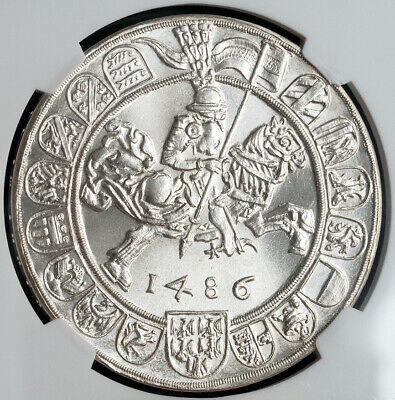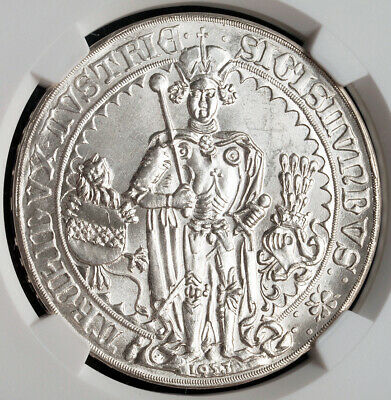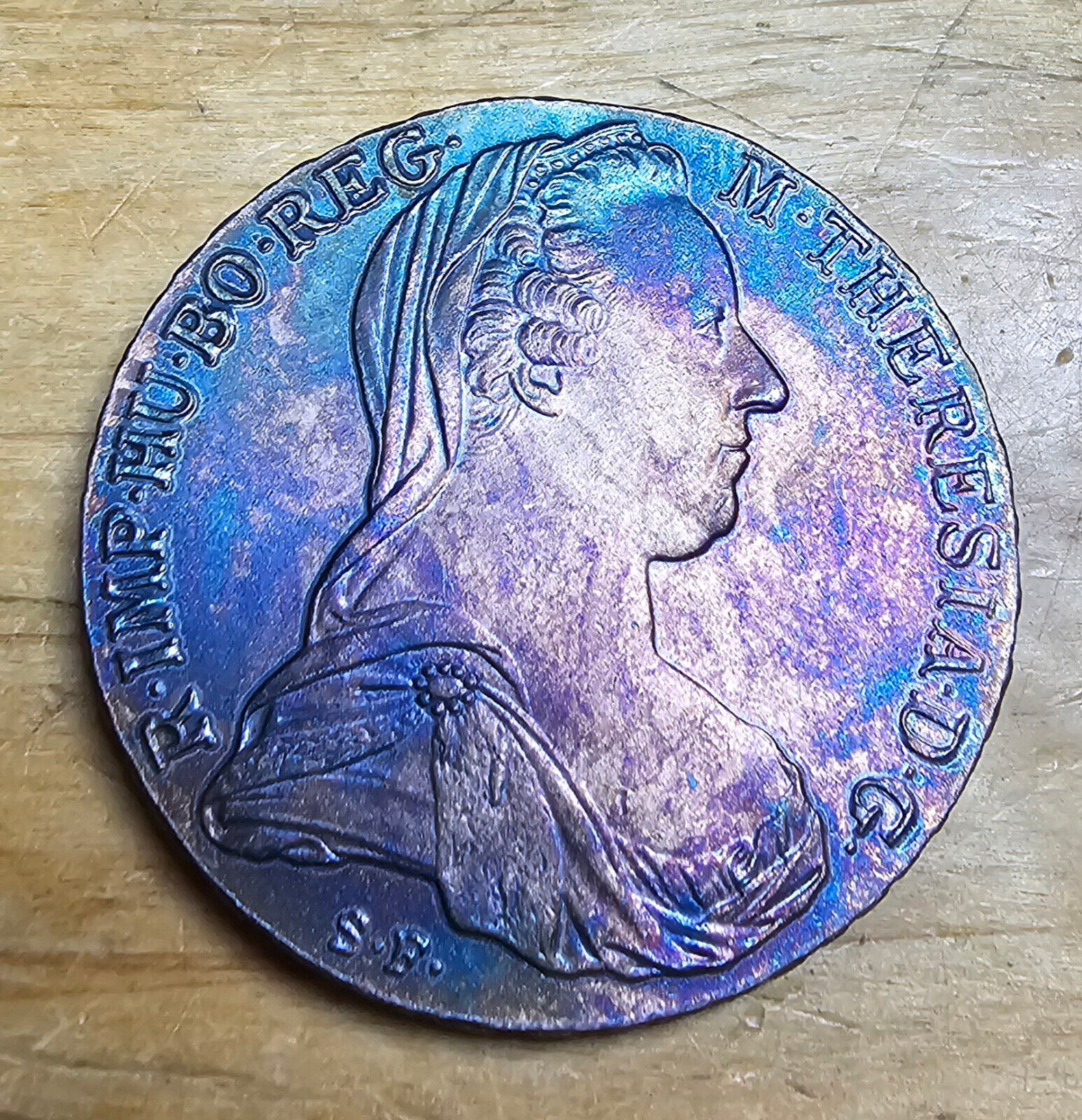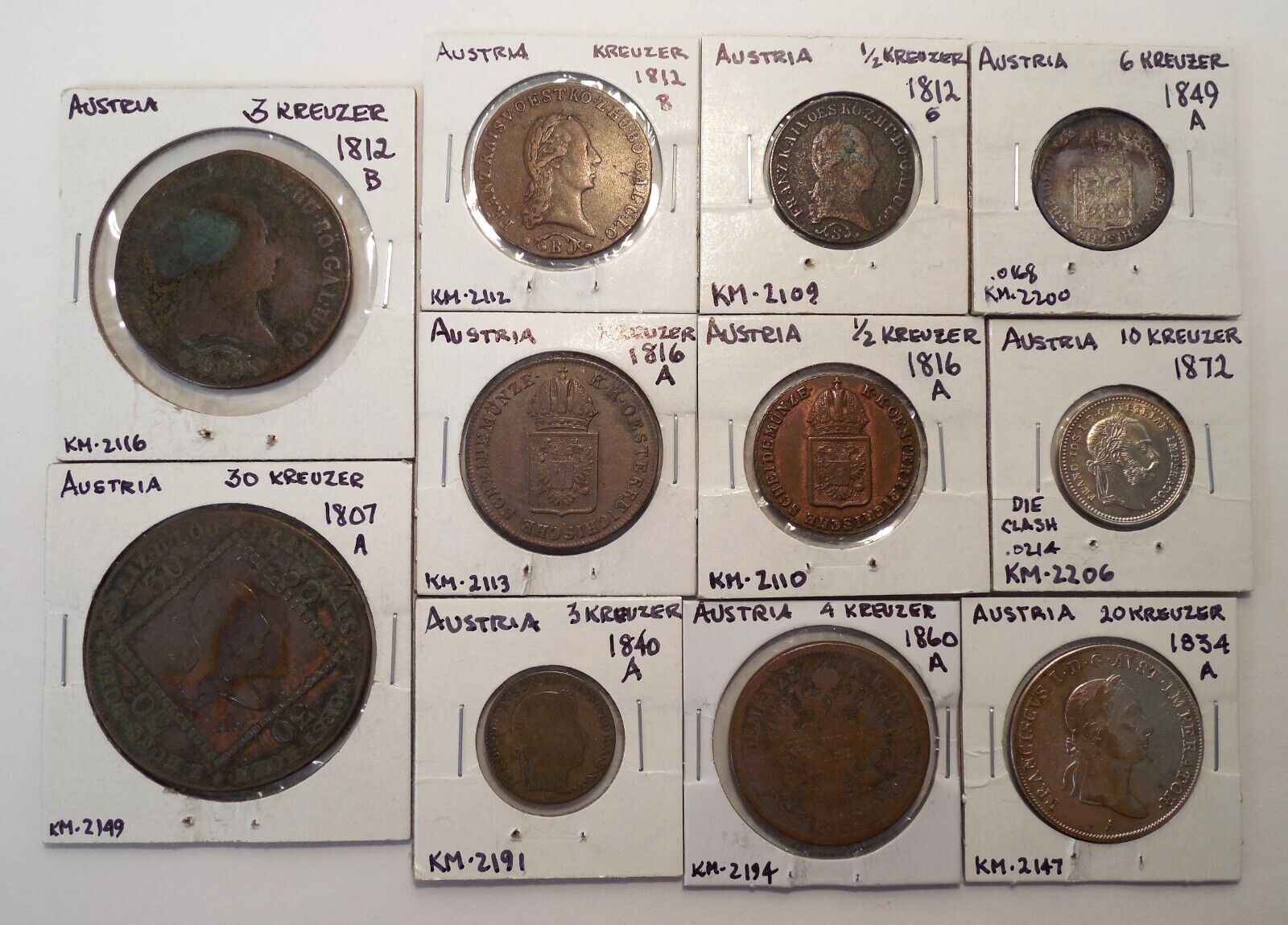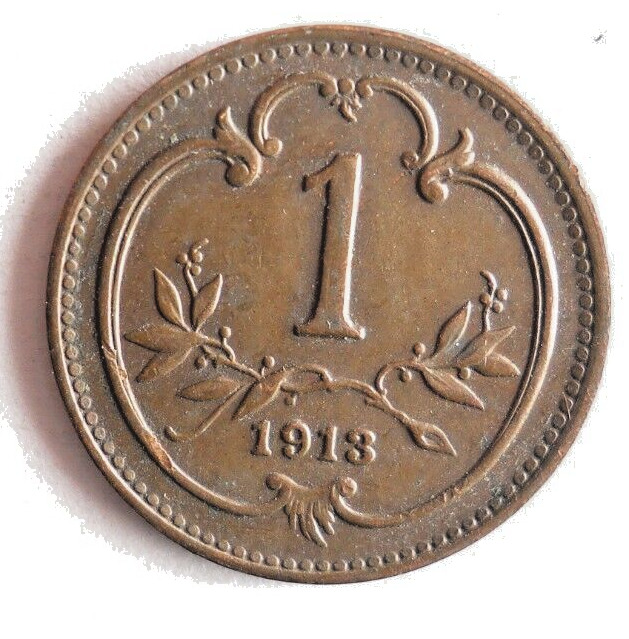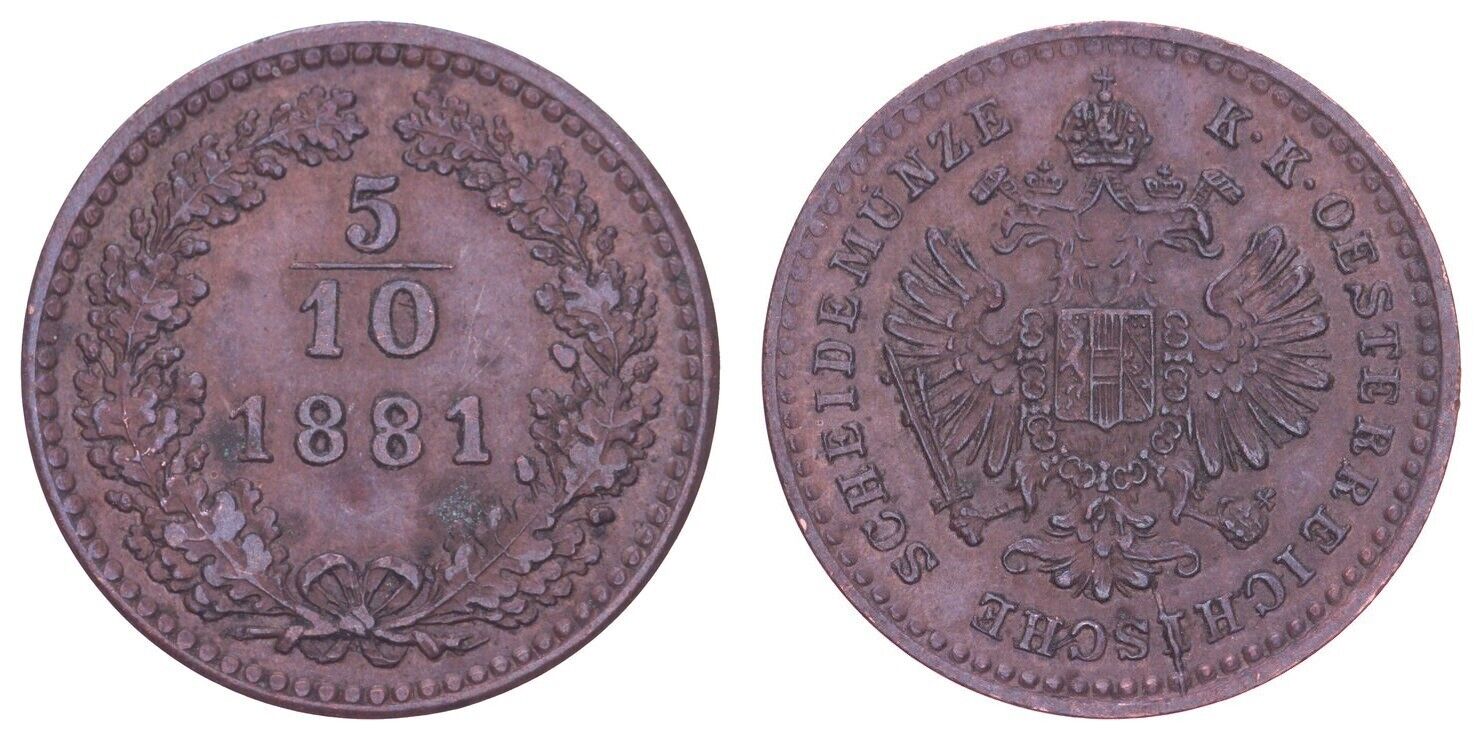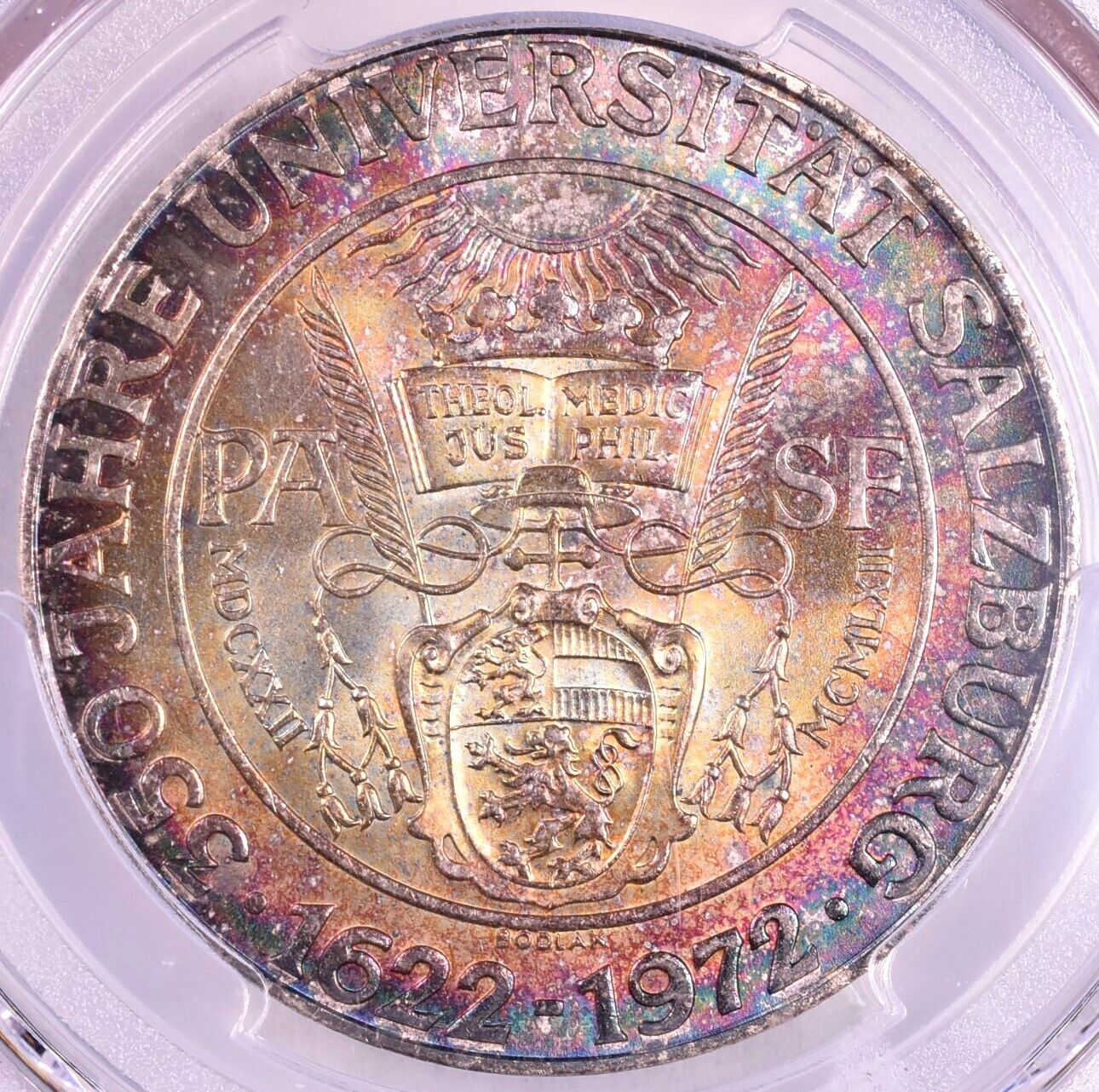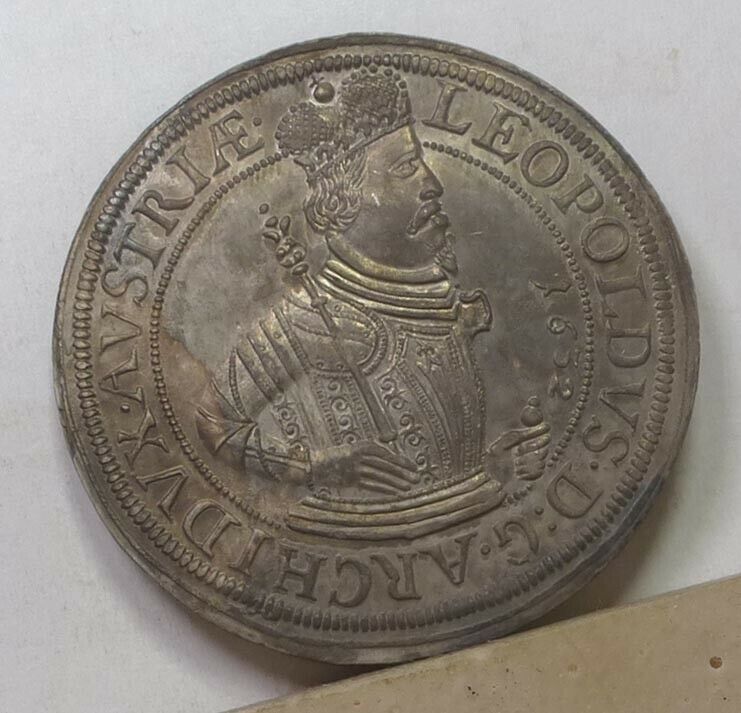-40%
1486/1953, Austria, Archduke Sigismund. Silver Guldiner. Restrike! NGC MS-67!
$ 143.16
- Description
- Size Guide
Description
CoinWorldTV1486/1953, Austria, Archduke Sigismund. Silver Guldiner Coin. Restrike! PCGS MS-67!
Mintage: 5000 pcs.
Mint Place: Hall (Tyrol)
References: Bruce X#M28.
Condition:
Certified and graded by PCGS as MS-67!
Mint year: 1953 (
Official restrike of the legendary 1486 issue!
)
Denomination: Guldiner (Guldengroschen) -
Official Restrike!
Material: Silver (.900)
Diameter: 40mm
Weight: 31.8gm
Obverse:
Sigismund standing in armor,wearing crown and holding orb; shield to left, crested helmet to right, restrike date (1953) below.
Legend: . SIGISMVNDVS : *: ARCHIDVX. AVSTRIE.
Reverse:
Armored knight on horseback right, carrying banner. Date (1486) below. All within circle of 16 shields.
The
Guldengroschen
was a large silver coin originally minted in Tirol in 1486. The Guldengroschen's name comes from the fact that it has an equivalent denomination value in silver relative to that of the goldgulden (60 kreuzer). In the latter years of the 1470s and early years of the 1480s Sigismund of Austria issued decrees that reformed the poor state of his region's coinage by improving the silver fineness back to a level not seen in centuries (.937 pure) and created denominations larger than the ubiquitous, but fairly low valued Groschen of 4 to 6 Kreuzer that were in use. In 1484, small numbers of "half guldengroschens" valued at 30 kreuzer were issued. This was a revolutionary leap in denomination from the smaller pieces, and surpassed even the large testones of Italy which were the highest weight coins in use. Finally in 1486 the full sized guldengroschen of 60 kreuzers was put into circulation and it was soon nicknamed "guldiner". For a long time thereafter such coins were also called "unciales" because their actual silver weight was very nearly one ounce. As large quantities of silver became available other states began issuing guldiners of their own. Bern, in modern day Switzerland was one of the earliest to follow Tirol by issuing its guldiners in 1493. In 1500, Saxony's mint at Annaberg took minting of guldiners to new heights and the economies of central Europe welcomed these large new coins. The original Tiroler guldiner was designed so that eight coins minted would weigh in pure silver at one Tiroler Mark. This was fine for Tirol, but much of Europe was accustomed to measuring by the more widely used Cologne mark. The penultimate development of the guldiner occurred in 1518 when the Joachimsthal mint in Habsburg-controlled Bohemia slightly altered the weight of the coin from 31.93 g down to 29.20 g. This made it possible to mint nine guldiners to have the silver weight equivalent of one Cologne Mark, rather than the eight in Tirol. This new coin was known as the Joachimsthaler (Joachimsthal guldiner), but like the guldengroschen being contracted to guldiner, the joachimsthaler became known simply as the thaler. This new coin was an instant success and was the great grandfather of many other similar weight coins like the daalder, dollar, tolar, tallero, etc.
Authenticity unconditionally guaranteed.
Bid with confidence!
Sigismund
(
February 14
, 1368
–
December 9
, 1437
) was Holy Roman Emperor for four years from 1433 until 1437, and the last Emperor of the House of Luxemburg. He was also one of the longest ruling Kings of Hungary, reigning for fifty years from 1387 to 1437. He also was King of Bohemia from 1419, of Lombardia from 1431, and of Germany from 1411. Sigismund was one of the driving forces behind the Council of Constance that ended the Papal Schism, but which in the end also led to the Hussite Wars that dominated the later period of Sigismund's life.
At the death of her father in 1382, his betrothed, Mary, became the Queen of Hungary and Sigismund married her in 1385 in Zólyom (today Zvolen). She was however captured, together with her mother who has acted as the Regent of Hungary, in the following year by the rebellious Horvathys, Bishop Paul of Machva, his brother Ivanish and younger brother Ladislaus. This was according to an elaborate plan by the seventeen year-old Sigismund himself, and his mother-in-law was strangled (allegedly by Sigismund's men) in January 1387. Mary was only rescued in June 1387 through the aid of the Venetians (her uncle by adoption, Stefan Tvrtko of Bosnia, became then an honorary Venetian citizen), and she apparently reconciled with the Horvathys. Mary never forgave Sigismund for the death of her beloved mother, despite his claim to have punished the murderers, and they subsequently lived separate lives and had separate households. She died in 1395 in a suspicious horse accident while heavily pregnant.
In the meantime, Sigismund had arranged his own coronation as King of Hungary on
31 March 1387
, and having raised money by pledging Brandenburg to his cousin Jobst, margrave of Moravia (1388), he was engaged for the next nine years in a ceaseless struggle for the possession of this unstable throne. It was not for entirely selfless reasons that one of the leagues of barons helped him to power: Sigismund had to pay for the support of the lords by transferring a sizeable part of the royal properties. (For some years, the baron's council governed the country in the name of the Holy Crown ) The restoration of the authority of the central administration took decades of work. The bulk of the nation headed by the great Garai family was with him; but in the southern provinces between the Save and the Drave, the Horvathys with the support of King Tvrtko I of Bosnia, Mary's maternal uncle, proclaimed as their king Ladislas, king of Naples, son of the murdered Charles II of Hungary. Not until 1395 did Nicholas II Garay succeed in suppressing them. On a number of occasions, Sigismund was imprisoned by nobles, but skilfully bribed his way out.
In 1396 Sigismund led the combined armies of Christendom against the Turks, who had taken advantage of the temporary helplessness of Hungary to extend their dominion to the banks of the Danube. This
Last Crusade
, preached by Pope Boniface IX, was very popular in Hungary. The nobles flocked in thousands to the royal standard, and were reinforced by volunteers from nearly every part of Europe, the most important contingent being that of the French led by John the Fearless, son of Philip II, Duke of Burgundy. Sigismund set out with 90,000 men and a flotilla of 70 galleys. After capturing Vidin, he camped before the fortress of Nicopolis. Sultan Bayezid I raised the siege of Constantinople and, at the head of 140,000 men, completely defeated the Christian forces in the Battle of Nicopolis fought between 25 and
28 September 1396
. He returned across the sea and through the realm of Zeta, where he ordained a local Serb lord Ðurad II with the islands of Hvar and Korcula for resistance against the Turks, which were returned to Sigismund after his death in April of 1403.
Deprived of his authority in Hungary, Sigismund then turned his attention to securing the succession in Germany and Bohemia, and was recognized by his childless half-brother Wenceslaus IV as Vicar-General of the whole Empire. However, he was unable to support Wenceslaus when he was deposed in 1400 and Rupert of Germany, Elector Palatine, was elected German king in his stead.
During these years he was also involved in domestic difficulties, out of which sprang a second war with Ladislas of Naples; on his return to Hungary in 1401 he was once imprisoned and twice deposed. This struggle in its turn led to a war with the Republic of Venice, as Ladislas had sold the Dalmatian cities to the Venetians for 100,000 ducats before departing to his own land. In 1401 Sigismund assisted a rising against Wenceslaus, during the course of which the Bohemian king was made a prisoner, and Sigismund ruled Bohemia for nineteen months. He released Wenceslaus in 1403.
In 1404 he introduced the
Placetum Regium
. According to this decree, Papal bulls could not be pronounced in Hungary without the consent of the king.
In about 1406 he remarried Mary's cousin Barbara of Celje (Barbara Celjska, nicknamed the "Messalina of Germany"), daughter of Count Hermann II of Celje. Hermann's mother Katarina Kotromanic (of the House of Kotromanic) and Mary's mother Queen Elizabeta (Elisabeth of Bosnia) were sisters, or cousins who were adopted sisters. Tvrtko I was their first cousin and adopted brother, and perhaps even became heir apparent to Queen Mary. Tvrtko may have been murdered in 1391 on Sigismund's order.
Sigismund personally lead an army of almost 50,000 "crusaders" against the Croats and Bosnians, which culminated in 1408 with the Battle of Dobor, and a massacre of about 200 noble families, many of them victors of numerous battles against the Ottomans. He founded his personal order of knighthood, the Order of the Dragon, after this victory. Members of the order were mostly his political allies and supporters. During his long reign Royal castle of Buda became probably the largest Gothic palace of the late Middle Ages.
Only 1$ shipping for each additional item purchased!
